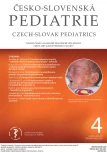Severe combined immunodeficiency in set of patients from national institute of children’s diseases
Authors:
V. Urdová 1; J. Horáková 1; P. Švec 1; I. Boďová 1; S. Šufliarska 1; M. Makohusová 1; D. Dóczyová 1; M. Pozdechová 1; A. Kolenova 1; M. Jeseňák 3
; A. Šoltýsová 4; A. Ficek 4; Z. Tkáčová Tomečková 4; P. Čižnár 2
Authors‘ workplace:
Transplantačná jednotka kostnej drene Kliniky detskej hematológie a onkológie, NÚDCH, Bratislava, Slovensko
1; Detská klinika NÚDCH a LF Univerzity Komenského, Bratislava, Slovensko
2; Centrum pre vrodené poruchy imunity, Klinika detí a dorastu, Jesseniova lekárska fakulty v Martine, Univerzita Komenského, v Bratislave, Univerzitná nemocnica Martin, Slovensko
3; Katedra molekulárnej biológie Prírodovedeckej fakulty UK, Bratislava, Slovensko
4
Published in:
Čes-slov Pediat 2021; 76 (4): 184-193.
Category:
Overview
Severe combined immunodeficiency (SCID) is a life-threatening condition characterized by impaired cellular and humoral immune responses. SCID represents one of the most severe forms of primary immunodeficiency (PID) disorders. As a result of severe infection can lead to early infant death.
Objective: The aim of the study was to analyze the individual characteristics in the group of patients with SCID in Slovakia and to evaluate the results of treatment with hematopoietic stem cell transplantation in order to map the overall state of diagnosis, therapy and prognosis of patients diagnosed with SCID.
Methods: In clinical part we have retrospectively evaluated the group of pediatric patients with severe combined immunodeficiency. In the period of 15 years (2003–2017), a total of 16 patients with SCID were treated in National Institute of Children´s Diseases. Of the 16 patients 11 underwent hematopoetic stem cell transplantation.
Results: 2-year overall survival rate of children with SCID was 68.8%. Genetic defect was confirmed in 13 children with IL2RG as the most common mutation. The median age at the diagnosis was 122 days which was associated with higher incidence of infection before HSCT. Infection before HSCT was confirmed in 73% of patients. Due to infectious complications four patients died before HSCT. 100% patients had absence of TREC episomes which was eluated by analysis of dry blood spots. 2-year overall survival rate of children after HSCT was 90.9%.
Conclusion: Early diagnosis of SCID, before the onset of severe infections, increases the chances of getting the patients safely to HSCT. The TREC diagnosis in our sample confirmed the excellent sensitivity and specificity of the method and its implementation in neonatal screening, following the example of many countries around the world, would be beneficial in improving the morbidity and mortality of patients diagnosed with SCID. Until its introduction it is necessary to streamline early diagnosis based on characteristic clinical symptoms and the subsequent centralization of patients into centers with experience in the treatment of SCID patients.
Keywords:
severe combined immunodeficiency – hematopoietic stem cell transplantation – TREC – early diagnosis – survival
Sources
1. Tangye SG, Al-Herz W, Bousfiha A. Human inborn errors of immunity: 2019 Update on the Classification from the International Union of Immunological Societies Expert Committee. J Clin Immunol 2020; 40 (1): 24–64.
2. Kwan A. Newborn screening for severe combined immunodeficiency in 11 screening programs in the United States. JAMA 2014; 312 (7): 729–738.
3. Heimall J. Immune reconstitution and survival of 100 SCID patients post-hematopoietic cell transplant: a PIDTC natural history study. Blood 2017; 130 (25): 2718–2727.
4. Fischer A, Notarangelo LD, Neven B, et al. Severe combined immunodeficiencies and related disorders. Nat Rev Dis Prim 2015; 1 : 15061.
5. Gennery AR. Omenn’s syndrome occurring in patients without mutations in recombination activating genes. Clin Immunol 2005; 116 (3): 246–256.
6. Chan K, Puck JM. Development of population-based newborn screening for severe combined immunodeficiency. J Allergy Clin Immunol 2005; 115 (2): 391–398.
7. Douek DC. Changes in thymic function with age and during the treatment of HIV infection. Nature 1998; 396 (6712): 690–695.
8. http://www.info4pi.org/town-hall/newborn-screening. Jeffrey Model Foundation.
9. Heimall J, Cowan MJ. Long term outcomes of severe combined immunodeficiency: therapy implications. Expert Rev Clin Immunol 2017; 13 (11): 1029–1040.
10. Šufliarska S, Horáková J, Boďová I. Transplantácia krvotvorných buniek v pediatrickej onkológii. Onkológia 2006; 1 (2): 93–97.
11. Cavazzana M, Six E, Lagresle-Peyrou C, André-Schmutz I. Gene therapy for X-linked severe combined immunodeficiency: Where do we stand? Hum Gene Ther 2016; 27 (2): 108–116.
12. Kaplan EL, Meier P. Nonparametric estimation from incomplete observations. J Am Stat Assoc 1958; 53 : 457–481.
13. Mantel N. Evaluation of survival data and two new rank order statistics arising in its consideration. Cancer Chemother Rep 1966 Mar; 50 (3): 163–170.
14. IBM Corp. Released, IBM SPSS Statistics for Windows, Version 20.0, 2011.
15. Šufliarska S, Horáková J, Boďová I. Závažná BCG-itída u detí s vrodenou imunodeficienciou. Pediatr pre prax 2012; 13 (6): 268–270.
16. Gaspar HB. Long-term persistence of a polyclonal T cell repertoire after gene therapy for X-linked severe combined immunodeficiency. Sci Transl Med 2011 Aug; 3 (97).
17. Rota IA, Dhalla F. FOXN1 deficient nude severe combined immunodeficiency. Orphanet J Rare Dis 2017; 12 (1): 6.
18. Čižnár P, Horáková J. Novorodenecký skríning primárnych imunodeficiencií. Pediatr pre prax 2014; 15 (2): 52–56.
19. Pasic S, Vujic D, Veljković D. Severe combined immunodeficiency in Serbia and Montenegro between years 1986 and 2010: a single-center experience. J Clin Immunol 2014; 34 (3): 304–308.
20. Neven B, Leroy S, Decaluwe H, et al. Long-term outcome after hematopoietic stem cell transplantation of a single-center cohort of 90 patients with severe combined immunodeficiency. Blood 2009; 113 (17): 4114–4124.
Labels
Neonatology Paediatrics General practitioner for children and adolescentsArticle was published in
Czech-Slovak Pediatrics

2021 Issue 4
- What Effect Can Be Expected from Limosilactobacillus reuteri in Mucositis and Peri-Implantitis?
- The Importance of Limosilactobacillus reuteri in Administration to Diabetics with Gingivitis
Most read in this issue
- Autoinflammatory diseases in the paediatric praxis – case series
- MUDr. Pavel Frühauf, CSc., emeritní primář, sedmdesátníkem
- Congenital neutropenia in children
- The complement system I: innate defects of complement cascade proteins excluding hereditary angioedema
